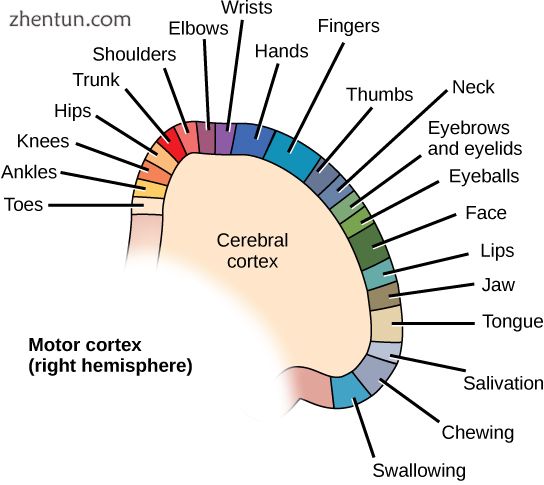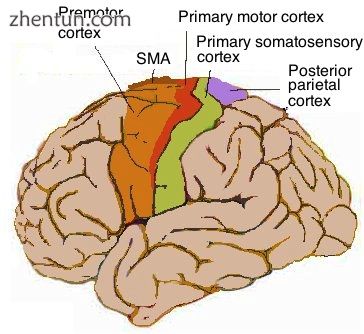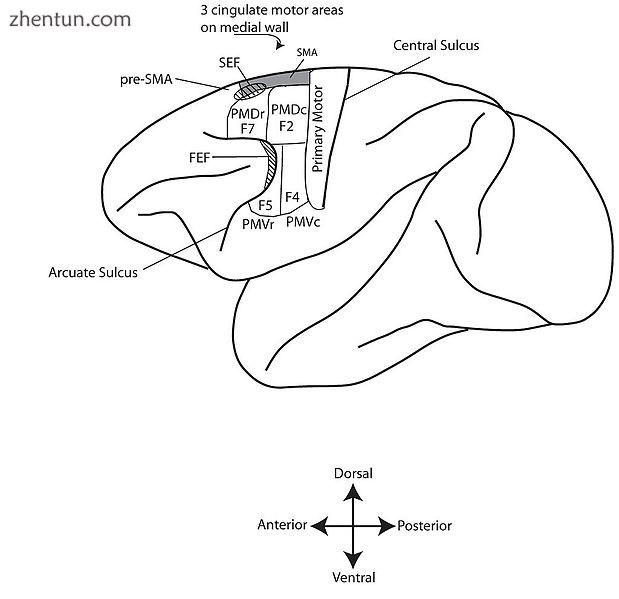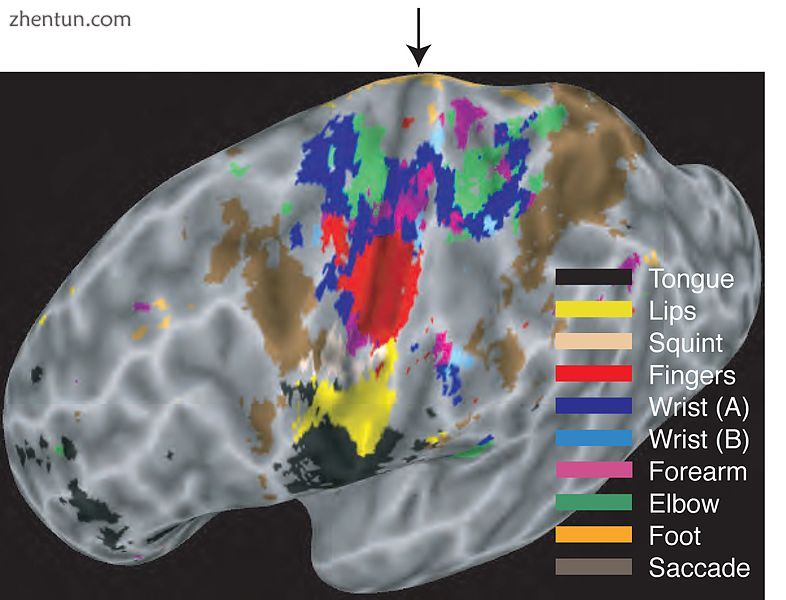运动皮层是参与自愿运动的计划,控制和执行的大脑皮层区域。 经典地,运动皮层是位于中央沟前方的后中央前回的额叶区域。
视频:↓ 2分钟神经科学 - 运动皮质
https://cache.tv.qq.com/qqplayerout.swf?vid=l0867qhl9j4

运动皮层控制不同的肌肉群

人体运动皮层的地形
目录
1 运动皮层的组成部分
1.1 前运动皮质
1.2 辅助运动皮质
2 历史
3 运动皮质图
4 运动皮层的演变
5 参考文献
运动皮层的组成部分
运动皮层可分为三个区域:
1.初级运动皮层是产生神经冲动的主要因素,神经冲动传递到脊髓并控制运动的执行。然而,大脑中的一些其他运动区域也在这个功能中起作用。它位于内侧表面的前旁中心小叶上。
2.运动前皮层负责运动控制的某些方面,可能包括运动准备,运动的感觉指导,到达的空间引导,或直接控制一些运动,重点是控制近端和躯干肌肉的身体。位于初级运动皮层前方。
3.辅助运动区域(或SMA)具有许多提出的功能,包括内部产生的运动计划,运动顺序的计划,以及身体两侧的协调,例如双手协调。位于初级运动皮层前半球的中线表面。
后顶叶皮层有时也被认为是运动皮层区域的一部分;然而,最好将它视为一个联合皮质而不是运动。它被认为负责将多感官信息转换为运动命令,并负责运动规划的某些方面,以及许多其他可能与运动无关的功能。
初级躯体感觉皮层,特别是称为区域3a的部分,直接位于运动皮层,有时被认为是运动控制电路的功能部分。
大脑皮层外的其他大脑区域对运动功能也非常重要,最明显的是小脑,基底神经节,小脑桥核和红核,以及其他皮质下运动核。
前运动皮质
在最早的运动皮层研究中,研究人员只认识到一个涉及运动控制的皮层领域。阿尔弗雷德沃尔特坎贝尔[1]是第一个提出可能有两个领域,一个“主要”运动皮层和一个“中间前置”运动皮层。他的理由很大程度上是基于细胞构筑学,或者在显微镜下研究皮质的外观。初级运动皮层包含称为“Betz细胞”的巨细胞体细胞。这些细胞被错误地认为是皮质的主要输出,将纤维传递到脊髓。[1]此后发现Betz细胞约占皮质到脊髓的投影的2-3%,或约占初级运动皮层到脊髓的10%[2] [3]。 Betz细胞的特定功能将它们与运动皮层的其他输出细胞区分开来仍然未知,但它们仍然被用作初级运动皮层的标​​记物。
其他研究人员,如Vogt和Vogt [4]以及Otfrid Foerster [5]也提出,运动皮层被分为初级运动皮层(根据Brodmann [6]命名方案的区域4)和高级运动皮层(区域6根据Korbinian Brodmann)。
Wilder Penfield [7] [8]明显不同意并建议区域4和区域6之间没有功能区别。在他看来,两者都是同一地图的一部分,尽管区域6倾向于强调背部和颈部的肌肉。研究猴子运动图谱的Woolsey [9]也认为初级运动和前运动之间没有区别。 M1是提议的单一地图的名称,包括初级运动皮层和前运动皮层。[9]虽然有时“M1”和“初级运动皮层”可以互换使用,但严格来说,它们来源于运动皮层组织的不同概念。
尽管有Penfield和Woolsey的观点,但共识出现了第4区和第6区具有足够不同的功能,它们可被视为不同的皮质区。 Fulton [10]帮助巩固了区域4中的初级运动皮层和区域6中的前运动皮层之间的区别.Fudon指出,并且随后的研究已经证实,初级运动和前运动皮层都直接投射到脊髓。并且能够直接控制运动。富尔顿表示,当实验动物的初级运动皮层受损时,运动很快就会恢复;当前运动皮层受损时,运动很快恢复;当两者都受损时,运动就会丧失,动物无法恢复。

一些普遍接受的猴皮质运动系统的分裂
前运动皮层现在一般分为四个部分。[11] [12] [13]首先,它分为上(或背侧)前运动皮层和下(或腹侧)前运动皮层。这些中的每一个进一步分为更靠近大脑前部的区域(延髓前运动皮层)和更靠近后部的区域(尾部前运动皮层)。通常使用一组首字母缩略词:PMDr(前运动员背侧,嘴侧),PMDc,PMVr,PMVc。一些研究人员使用不同的术语。字段7或F7表示PMDr; F2 = PMDc; F5 = PMVR; F4 = PMVC。
PMDc经常被研究其在指导到达方面的作用。[14] [15] [16] PMDc中的神经元在到达期间是活跃的。当训练猴子从中心位置到达一组目标位置时,PMDc中的神经元在准备到达范围期间以及在到达范围内时是活跃的。它们经过广泛调整,可以最好地适应一个方向,不太适应不同方向。据报道,PMDc在行为时间尺度上的电刺激引起肩部,手臂和手部的复杂运动,类似于在准备抓握时伸开的手。[11]
PMDr可以参与学习将任意感官刺激与特定动作相关联或学习任意反应规则。[17] [18] [19]在这个意义上,它可能比其他运动皮层领域更像前额皮质。它也可能与眼球运动有某种关系。 PMDr中的电刺激可以引起眼球运动[20],并且PMDr中的神经元活动可以通过眼球运动来调节。[21]
PMVc或F4经常被研究其在运动的感觉指导中的作用。这里的神经元对触觉刺激,视觉刺激和听觉刺激有反应。[22] [23] [24] [25]在所谓的周围空间中,这些神经元对身体周围的空间中的物体特别敏感。对这些神经元的电刺激导致明显的防御性运动,就像保护体表一样。[26] [27]该运动前区域可以是较大电路的一部分,用于维持身体周围的安全边缘并引导相对于附近物体的运动。[28]
PMVr或F5经常被研究其在抓握过程中塑造手的作用以及手和嘴之间的相互作用。[29] [30]当在行为时间尺度上施加刺激时,对F5的至少一些部分的电刺激引起复杂的运动,其中手移动到嘴部,闭合在握柄中,定向使得握柄面向嘴部,颈部转动将嘴对准手,嘴巴张开。[11] [26]
镜像神经元首先在Rizzolatti及其同事的猴脑区域F5中发现[31] [32]。当猴子抓住一个物体时,这些神经元是活跃的。然而,当猴子观察实验者以同样的方式抓住物体时,相同的神经元变得活跃。因此神经元既是感觉的又是运动的。通过使用自己的电机控制电路在内部模仿动作,建议镜像神经元成为理解其他动作的基础。
辅助运动皮质
Penfield [33]在皮质的顶部或背部描述了皮质运动区,即辅助运动区(SMA)。 SMA中的每个神经元都可能影响许多肌肉,许多身体部位和身体两侧。[34] [35] [36]因此,SMA中的身体地图广泛重叠。 SMA直接投射到脊髓,可能在控制运动方面发挥一些直接作用。[37]
基于在人脑中使用脑成像技术的早期工作,Roland [38]提出SMA在内部生成的计划中特别活跃,以制作一系列运动。在猴脑中,SMA中的神经元与特定的学习运动序列相关联。[39]
其他人则认为,由于SMA似乎在双边控制运动,它可能在人工间协调中发挥作用。[40]
还有人认为,由于SMA直接投射到脊髓,并且由于其在简单运动中的活动,它可能在运动控制中发挥直接作用,而不仅仅是计划序列中的高级别角色。[37] [ 41]
根据电刺激期间引起的运动,有人提出SMA可能已经在灵长类动物中进化,作为涉及攀爬和其他复杂运动的运动曲目部分的专家。[11] [42]
根据对脊髓的投射模式,有人建议另一组运动区可能位于辅助运动区旁边,在半球的内侧(或中线)壁上。[37]这些内侧区域被称为扣带运动区域。它们的功能尚不清楚。
历史
1870年,Eduard Hitzig和Gustav Fritsch证明,对大脑某些部位的电刺激会导致身体另一侧的肌肉收缩。[43]
不久之后,在1874年,大卫·费里尔[44]在韦克菲尔德的西部骑行疯人院实验室工作(应其导演詹姆斯·克莱顿 - 布朗的邀请),使用电刺激绘制了猴脑中的运动皮层。 。他发现,运动皮层包含在主体与脚的粗略地图在大脑的顶部(或背侧部)和脸在大脑底部(或腹侧部分)。他还发现,当电刺激维持较长时间(例如一秒钟)而不是在几分之一秒内放电时,可能会引起一些协调的,看似有意义的运动,而不仅仅是肌肉抽搐。
在Ferrier发现之后,许多神经科学家使用电刺激来研究许多动物(包括猴子,猿和人)的运动皮层图谱。[1] [4] [5] [45] [46]
Campbell在1905年描述了人类运动皮层的第一个详细地图之一。[1]他对截肢者的大脑进行了解剖。失去手臂的人随着时间的推移显然会失去通常控制手臂的运动皮层部分的一些神经元质量。同样地,失去腿的人会在运动皮层的腿部显示变性。通过这种方式可以建立运动地图。在1919年至1936年期间,其他人使用电刺激详细绘制了运动皮层,包括丈夫和妻子团队Vogt和Vogt [4]以及神经外科医生Foerster。[5]
也许人类运动地图上最著名的实验由Penfield于1937年发表。[7] [8]他使用20世纪30年代常见的手术,检查了接受脑部手术的癫痫患者。这些患者接受局部麻醉,打开头骨,露出大脑。然后,将电刺激应用于大脑表面以绘制出语音区域。以这种方式,外科医生将能够避免对语音电路的任何损坏。然后可以手术切除癫痫的大脑焦点。在此过程中,Penfield绘制了大脑皮层所有部位(包括运动皮层)的电刺激效果。
Penfield有时被误认为是运动皮层中地图的发现者。它在他工作前大约70年被发现。然而,彭菲尔德描绘了一张在皮质表面上伸展的类人形象的图片,并使用术语“小脑”(小于“同性恋”,拉丁语为“男人”)来指代它。也许是因为这个原因,他的作品在神经科学中变得如此受欢迎。
运动皮质图
一个简单的观点,几乎肯定是太有限,可以追溯到最早的运动皮层工作,是运动皮层神经元通过前馈直接通路控制运动。在该视图中,运动皮层中的神经元向脊髓发送轴突或投射并在运动神经元上形成突触。运动神经元向肌肉发送电脉冲。当皮质中的神经元变得活跃时,它会导致肌肉收缩。运动皮层的活动越大,肌肉力量越强。运动皮层中的每个点控制肌肉或一小组相关肌肉。该描述仅部分正确。
运动皮层中的大多数神经元投射到脊髓中间神经元电路上的脊髓突触,而不是直接进入运动神经元。[47]一个建议是,直接的皮质运动神经元投射是一种专门化,可以精确控制手指。[47] [48]
运动皮层中的每个点控制肌肉或一组有限的相关肌肉的观点在整个运动皮层研究史上都有争议,并且以最强和最极端的形式由Asanuma [49]提出。使用电刺激在猫和猴子中进行的实验。然而,几乎所有其他检查地图的实验,包括Ferrier [44]和Penfield [7]的经典工作表明,运动皮层中的每个点都会影响一系列肌肉和关节。地图非常重叠。在前运动皮质和辅助运动皮质中,图中的重叠通常更大,但即使是初级运动皮层中的图也以广泛重叠的方式控制肌肉。许多研究已经证明了运动皮层中肌肉的重叠表现。[50] [51] [52] [53] [54] [55] [56]
据信,当动物学习复杂的运动曲目时,运动皮层逐渐在肌肉之间进行协调。[57] [58]

人体大脑中的身体地图。
肌肉协调运动皮层复杂运动的最明显例子来自Graziano及其同事对猴脑的研究。[11] [26]他们在行为时间尺度上使用电刺激,例如半秒而不是更典型的百分之一秒。他们发现猴子运动皮层的这种类型的刺激经常引起复杂,有意义的行为。例如,刺激皮质中的一个部位会导致手闭合,移动到嘴巴,嘴巴打开。刺激另一个部位会导致手打开,旋转直到握把面向外,并且手臂突出,就像动物到达一样。从不同的位置引起不同的复杂运动,并且在所有测试的猴子中以相同的有序方式绘制这些运动。计算模型[59]表明,猴子的正常运动曲目如果排列在一张纸上,使得相似的运动彼此靠近,将产生一张与猴子运动皮层中的实际地图相匹配的地图。这项工作表明运动皮层并不真正包含身体的小脑型图。相反,更深层的原则可能是将运动曲目渲染到皮质表面上。如果运动曲目部分地分解为单独的身体部位的动作,则该地图包含研究人员在过去一个世纪中注意到的粗略且重叠的身体布置。
据报道,在典型的运动曲目中,猴子和上半身的后顶叶皮层[60] [61]以及大鼠的运动皮层[62] [63]和小鼠[64]也有类似的组织。
运动皮层的演变
哺乳动物在2亿年前从哺乳动物的爬行动物进化而来。[65]这些早期哺乳动物开发了几种新的脑功能,这很可能是由于这些哺乳动物占据的夜间生态位所必需的新型感觉过程。[66]这些动物很可能有一个躯体运动皮层,其中体感信息和运动信息在同一皮层区域进行处理。这允许仅获得简单的运动技能,例如四足运动和掠食者或猎物的击打。胎盘哺乳动物进化出大约100个mya的离散运动皮层。[65]根据适当质量原则,“控制特定功能的神经组织的质量适合于执行功能所涉及的信息处理量。[66]”这表明离散运动皮层的发育对于胎盘是有利的。哺乳动物和这些生物获得的运动技能比早期哺乳动物的祖先更复杂。此外,这种运动皮层是我们灵长类动物祖先的树栖生活方式所必需的。
运动皮层的增强(以及相对的拇指和立体视觉的存在)是进化上选择的,以防止灵长类动物在树枝之间跳跃的危险运动技能中出错(Cartmill,1974; Silcox,2007)。由于这种压力,树栖灵长类动物的运动系统具有不成比例的手和脚的躯体表现,这对于抓取是必不可少的(Nambu,2011; Pons等,1985; Gentilucci等,1988)。
另见
Motor skill
参考
Campbell, A. W. (1905). Histological Studies on the Localization of Cerebral Function. Cambridge, MA: Cambridge University Press. OCLC 6687137. Archived from the original on 2016-06-02.
Rivara CB, Sherwood CC, Bouras C, Hof PR (2003). "Stereologic characterization and spatial distribution patterns of Betz cells in the human primary motor cortex". The Anatomical Record Part A: Discoveries in Molecular, Cellular, and Evolutionary Biology. 270 (2): 137–151. doi:10.1002/ar.a.10015. PMID 12524689.
Lassek, A.M. (1941). "The pyramidal tract of the monkey". J. Comp. Neurol. 74 (2): 193–202. doi:10.1002/cne.900740202.
Vogt, C. and Vogt, O. (1919). "Ergebnisse unserer Hirnforschung". Journal für Psychologie und Neurologie. 25: 277–462.
Foerster, O (1936). "The motor cortex of man in the light of Hughlings Jackson's doctrines". Brain. 59 (2): 135–159. doi:10.1093/brain/59.2.135.
Brodmann, K (1909). Vergleichende Lokalisationslehre der Grosshirnrinde. Leipzig: J.A. Barth.
Penfield, W. and Boldrey, E. (1937). "Somatic motor and sensory representation in the cerebral cortex of man as studied by electrical stimulation". Brain. 60 (4): 389–443. doi:10.1093/brain/60.4.389.
Penfield, W. (1959). "The interpretive cortex". Science. 129 (3365): 1719–1725. doi:10.1126/science.129.3365.1719. PMID 13668523.
Woolsey, C.N., Settlage, P.H., Meyer, D.R., Sencer, W., Hamuy, T.P. and Travis, A.M. (1952). "Pattern of localization in precentral and "supplementary" motor areas and their relation to the concept of a premotor area". Association for Research in Nervous and Mental Disease. New York, NY: Raven Press. 30: 238–264.
Fulton, J (1935). "A note on the definition of the "motor" and "premotor" areas". Brain. 58 (2): 311–316. doi:10.1093/brain/58.2.311.
Graziano, M.S.A. (2008). The Intelligent Movement Machine. Oxford, UK: Oxford University Press.
Matelli, M., Luppino, G. and Rizzolati, G (1985). "Patterns of cytochrome oxidase activity in the frontal agranular cortex of the macaque monkey". Behav. Brain Res. 18 (2): 125–136. doi:10.1016/0166-4328(85)90068-3. PMID 3006721.
Preuss, T.M., Stepniewska, I. and Kaas, J.H (1996). "Movement representation in the dorsal and ventral premotor areas of owl monkeys: a microstimulation study". J. Comp. Neurol. 371 (4): 649–676. doi:10.1002/(SICI)1096-9861(19960805)371:4<649::AID-CNE12>3.0.CO;2-E. PMID 8841916.
Hochermann, S. & Wise, S.P (1991). "Effects of hand movement path on motor cortical activity in awake, behaving rhesus monkeys". Exp. Brain Res. 83 (2): 285–302. doi:10.1007/bf00231153. PMID 2022240.
Cisek, P & Kalaska, J.F (2005). "Neural correlates of reaching decisions in dorsal premotor cortex: specification of multiple direction choices and final selection of action". Neuron. 45 (5): 801–814. doi:10.1016/j.neuron.2005.01.027. PMID 15748854.
Churchland, M.M., Yu, B.M., Ryu, S.I., Santhanam, G. and Shenoy, K.V (2006). "Neural variability in premotor cortex provides a signature of motor preparation". J. Neurosci. 26 (14): 3697–3712. doi:10.1523/JNEUROSCI.3762-05.2006.
Weinrich, M., Wise, S.P. and Mauritz, K.H (1984). "A neurophyiological study of the premotor cortex in the rhesus monkey". Brain. 107 (2): 385–414. doi:10.1093/brain/107.2.385. PMID 6722510.
Brasted, P.J. & Wise, S.P (2004). "Comparison of learning-related neuronal activity in the dorsal premotor cortex and striatum". European J. Neurosci. 19 (3): 721–740. doi:10.1111/j.0953-816X.2003.03181.x.
Muhammad, R., Wallis, J.D. and Miller, E.K (2006). "A comparison of abstract rules in the prefrontal cortex, premotor cortex, inferior temporal cortex, and striatum". J. Cogn. Neurosci. 18 (6): 974–989. doi:10.1162/jocn.2006.18.6.974.
Bruce CJ, Goldberg ME, Bushnell MC, Stanton GB (1985). "Primate frontal eye fields. II. Physiological and anatomical correlates of electrically evoked eye movements". J. Neurophysiol. 54 (3): 714–734. PMID 4045546.
Boussaoud D (1985). "Primate premotor cortex: modulation of preparatory neuronal activity by gaze angle". J. Neurophysiol. 73 (2): 886–890. PMID 7760145.
Rizzolatti, G., Scandolara, C., Matelli, M. and Gentilucci, J (1981). "Afferent properties of periarcuate neurons in macaque monkeys, II. Visual responses". Behav. Brain Res. 2 (2): 147–163. doi:10.1016/0166-4328(81)90053-X. PMID 7248055.
Fogassi, L., Gallese, V., Fadiga, L., Luppino, G., Matelli, M. and Rizzolatti, G (1996). "Coding of peripersonal space in inferior premotor cortex (area F4)". J. Neurophysiol. 76 (1): 141–157. PMID 8836215.
Graziano, M.S.A., Yap, G.S. and Gross, C.G (1994). "Coding of visual space by premotor neurons". Science. 266 (5187): 1054–1057. doi:10.1126/science.7973661. PMID 7973661.
Graziano, M.S.A., Reiss, L.A. and Gross, C.G (1999). "A neuronal representation of the location of nearby sounds". Nature. 397 (6718): 428–430. doi:10.1038/17115. PMID 9989407.
Graziano, M.S.A., Taylor, C.S.R. and Moore, T. (2002). "Complex movements evoked by microstimulation of precentral cortex". Neuron. 34 (5): 841–851. doi:10.1016/S0896-6273(02)00698-0. PMID 12062029.
Cooke, D.F. and Graziano, M.S.A (2004). "Super-flinchers and nerves of steel: Defensive movements altered by chemical manipulation of a cortical motor area". Neuron. 43 (4): 585–593. doi:10.1016/j.neuron.2004.07.029. PMID 15312656.
Graziano, M.S.A. and Cooke, D.F. (2006). "Parieto-frontal interactions, personal space, and defensive behavior". Neuropsychologia. 44 (6): 845–859. doi:10.1016/j.neuropsychologia.2005.09.009. PMID 16277998.
Rizzolatti, G., Camarda, R., Fogassi, L., Gentilucci, M., Luppino, G. and Matelli, M (1988). "Functional organization of inferior area 6 in the macaque monkey. II. Area F5 and the control of distal movements". Exp. Brain Res. 71 (3): 491–507. doi:10.1007/bf00248742. PMID 3416965.
Murata, A., Fadiga, L., Fogassi, L., Gallese, V. Raos, V and Rizzolatti, G (1997). "Object representation in the ventral premotor cortex (area F5) of the monkey". J. Neurophysiol. 78: 2226–22230.
di Pellegrino, G., Fadiga, L., Fogassi, L., Gallese, V. and Rizzolatti, G (1992). "Understanding motor events: a neurophysiological study". Exp. Brain Res. 91 (1): 176–180. doi:10.1007/bf00230027. PMID 1301372.
Rizzolatti, G. & Sinigaglia, C (2010). "The functional role of the parieto-frontal mirror circuit: interpretations and misinterpretations". Nature Reviews Neuroscience. 11 (4): 264–274. doi:10.1038/nrn2805. PMID 20216547.
Penfield, W. & Welch, K (1951). "The supplementary motor area of the cerebral cortex: A clinical and experimental study". Am. Med. Ass. Arch. Neurol. Psychiat. 66 (3): 289–317. doi:10.1001/archneurpsyc.1951.02320090038004. PMID 14867993.
Gould, H.J. III, Cusick, C.G., Pons, T.P. and Kaas, J.H (1996). "The relationship of corpus callosum connections to electrical stimulation maps of motor, supplementary motor, and the frontal eye fields in owl monkeys". J. Comp. Neurol. 247 (3): 297–325. doi:10.1002/cne.902470303. PMID 3722441.
Luppino, G., Matelli, M., Camarda, R.M., Gallese, V. and Rizzolatti, G (1991). "Multiple representations of body movements in mesial area 6 and the adjacent cingulate cortex: an intracortical microstimulation study in the macaque monkey". J. Comp. Neurol. 311 (4): 463–482. doi:10.1002/cne.903110403. PMID 1757598.
Mitz, A.R. & Wise, S.P. (1987). "The somatotopic organization of the supplementary motor area: intracortical microstimulation mapping". J. Neurosci. 7 (4): 1010–1021. PMID 3572473.
He, S.Q., Dum, R.P. and Strick, P.L (1995). "Topographic organization of corticospinal projections from the frontal lobe: motor areas on the medial surface of the hemisphere". J. Neurosci. 15 (5 Pt 1): 3284–3306. PMID 7538558.
Roland, P.E., Larsen, B., Lassen, N.A. and Skinhoj, E (1980). "Supplementary motor area and other cortical areas in organization of voluntary movements in man". J. Neurophysiol. 43 (1): 118–136. doi:10.1152/jn.1980.43.1.118. PMID 7351547.
Halsband, U., Matsuzaka, Y. and Tanji, J. (1994). "Neuronal activity in the primate supplementary, pre-supplementary and premotor cortex during externally and internally instructed sequential movements". Neurosci. Res. 20 (2): 149–155. doi:10.1016/0168-0102(94)90032-9. PMID 7808697.
Brinkman, C (1981). "Lesions in supplementary motor area interfere with a monkey's performance of a bimanual coordination task". Neurosci. Lett. 27 (3): 267–270. doi:10.1016/0304-3940(81)90441-9. PMID 7329632.
Picard, N. & Strick, P.L (2003). "Activation of the supplementary motor area (SMA) during performance of visually guided movements". Cereb. Cortex. 13 (9): 977–986. doi:10.1093/cercor/13.9.977. PMID 12902397.
Graziano, M.S.A., Aflalo, T.N. and Cooke, D.F (2005). "Arm movements evoked by electrical stimulation in the motor cortex of monkeys". J. Neurophysiol. 94 (6): 4209–4223. doi:10.1152/jn.01303.2004. PMID 16120657.
Fritsch, G and Hitzig, E (1870). "über die elektrische Erregbarkeit des Grosshirns". Archiv fur Anatomie, Physiologie und Wissenschaftliche Medicin: 300–332. Translated in: von Bonin, G., ed. (1960). Some Papers on the Cerebral Cortex. Springfield IL: Charles Thomas. pp. 73–96.
Ferrier, D (1874). "Experiments on the brain of monkeys - No. 1". Proc. R. Soc. Lond. 23 (156–163): 409–430. doi:10.1098/rspl.1874.0058.
Beevor, C. and Horsley, V (1887). "A minute analysis (experimental) of the various movements produced by stimulating in the monkey different regions of the cortical centre for the upper limb, as defined by Professor Ferrier". Phil. Trans. R. Soc. Lond. B. 178: 153–167. doi:10.1098/rstb.1887.0006.
Grunbaum A. and Sherrington, C (1901). "Observations on the physiology of the cerebral cortex of some of the higher apes. (Preliminary communication)". Proc. R. Soc. Lond. 69 (451–458): 206–209. doi:10.1098/rspl.1901.0100.
Bortoff, G.A. & Strick, P.L. (1993). "Corticospinal terminations in two new-world primates: further evidence that corticomotoneuronal connections provide part of the neural substrate for manual dexterity". J. Neurosci. 13 (12): 5105–5118. PMID 7504721.
Heffner, R. & Masterton, B. (1975). "Variation in form of the pyramidal tract and its relationship to digital dexterity". Brain Behav. Evol. 12 (3): 161–200. doi:10.1159/000124401. PMID 1212616.
Asanuma, H. (1975). "Recent developments in the study of the columnar arrangement of neurons within the motor cortex". Physiol. Rev. 55 (2): 143–156. doi:10.1152/physrev.1975.55.2.143. PMID 806927.
Cheney, P.D. & Fetz, E.E. (1985). "Comparable patterns of muscle facilitation evoked by individual corticomotoneuronal (CM) cells and by single intracortical microstimuli in primates: evidence for functional groups of CM cells". J. Neurophysiol. 53 (3): 786–804. doi:10.1152/jn.1985.53.3.786. PMID 2984354.
Schieber, M.H. & Hibbard, L.S. (1993). "How somatotopic is the motor cortex hand area?". Science. 261 (5120): 489–492. doi:10.1126/science.8332915. PMID 8332915.
Rathelot, J.A. & Strick, P.L. (2006). "Muscle representation in the macaque motor cortex: an anatomical perspective". Proc. Natl. Acad. Sci. U.S.A. 103 (21): 8257–8262. doi:10.1073/pnas.0602933103. PMC 1461407. PMID 16702556.
Park, M.C., Belhaj-Saif, A., Gordon, M. and Cheney, P.D. (2001). "Consistent features in the forelimb representation of primary motor cortex in rhesus macaques". J. Neurosci. 21 (8): 2784–2792. PMID 11306630.
Sanes, J.N., Donoghue, J.P., Thangaraj, V., Edelman, R.R. and Warach, S. (1995). "Shared neural substrates controlling hand movements in human motor cortex". Science. 268 (5218): 1775–1777. doi:10.1126/science.7792606. PMID 7792606.
Donoghue, J.P., Leibovic, S. and Sanes, J.N. (1992). "Organization of the forelimb area in squirrel monkey motor cortex: representation of digit, wrist and elbow muscles". Exp. Brain Res. 89: 1–10. doi:10.1007/bf00228996.
Meier, J.D., Aflalo, T.N., Kastner, S. and Graziano, M.S.A. (2008). "Complex organization of human primary motor cortex: A high-resolution fMRI study". J. Neurophysiol. 100 (4): 1800–1812. doi:10.1152/jn.90531.2008. PMC 2576195. PMID 18684903.
Nudo, R.J., Milliken, G.W., Jenkins, W.M. and Merzenich, M.M. (1996). "Use-dependent alterations of movement representations in primary motor cortex of adult squirrel monkeys". J. Neurosci. 16 (2): 785–807. PMID 8551360.
Martin, J.H., Engber, D. and Meng, Z. (2005). "Effect of forelimb use on postnatal development of the forelimb motor representation in primary motor cortex of the cat". J. Neurophysiol. 93 (5): 2822–2831. doi:10.1152/jn.01060.2004. PMID 15574795.
Graziano, M.S.A. and Aflalo, T.N. (2007). "Mapping behavioral repertoire onto the cortex". Neuron. 56 (2): 239–251. doi:10.1016/j.neuron.2007.09.013. PMID 17964243.
Stepniewska, I., Fang, P.C. and Kaas, J.H. (2005). "Microstimulation reveals specialized subregions for different complex movements in posterior parietal cortex of prosimian galagos". Proc. Natl. Acad. Sci. U.S.A. 102 (13): 4878–4883. doi:10.1073/pnas.0501048102. PMC 555725. PMID 15772167.
Gharbawie, O.A., Stepniewska, I., Qi, H. and Kaas, J.H. (2011). "Multiple parietal-frontal pathways mediate grasping in macaque monkeys". J. Neurosci. 31 (32): 11660–11677. doi:10.1523/JNEUROSCI.1777-11.2011. PMC 3166522. PMID 21832196.
Haiss, F. & Schwarz, C (2005). "Spatial segregation of different modes of movement control in the whisker representation of rat primary motor cortex". J. Neurosci. 25 (6): 1579–1587. doi:10.1523/JNEUROSCI.3760-04.2005. PMID 15703412.
Ramanathan, D., Conner, J.M. and Tuszynski, M.H. (2006). "A form of motor cortical plasticity that correlates with recovery of function after brain injury". Proc. Natl. Acad. Sci. U.S.A. 103 (30): 11370–11375. doi:10.1073/pnas.0601065103. PMC 1544093. PMID 16837575.
Harrison, Thomas C.; Ayling, Oliver G. S.; Murphy, Timothy H. (2012). "Distinct Cortical Circuit Mechanisms for Complex Forelimb Movement and Motor Map Topography". Neuron. 74 (2): 397–409. doi:10.1016/j.neuron.2012.02.028. ISSN 0896-6273. PMID 22542191.
Kaas, J.H. (2004). "Evolution of somatosensory and motor cortex in primates". The Anatomical Record Part A: Discoveries in Molecular, Cellular, and Evolutionary Biology. 281 (1): 1148–1156. doi:10.1002/ar.a.20120. PMID 15470673.
Jerison, Harry (1973). Evolution of the Brain and Intelligence. Elsevier: Academic Press Inc. |